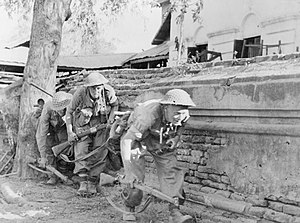Battle of Pwinmyo and Nagapakaung
This article is incomplete because it is pending further input from participants, or it is a work-in-progress by one author. Please comment on this article's talk page to share your input, comments and questions. Note: To contribute to this article, you may need to seek help from the author(s) of this page. |
The Battles of Pwinmyo (15 August - 20 November 1944) and Nagapakaung (4 September - 21 October 1944) took place in the region around the city of Pwinmyo and the small town of Nagapakaung located north of the former. The simultaneous battles were considered to be the final Quenminese offensive of the war.
While the Allied forces were halfway completed in the liberation of Bethausia, Quenminese Marshal Thạch Hung Sõn Chiến planned out in what would be the last Quenminese offensive operation of the war. Marshal Chien attempted to give the Allies a surprise by navigating to Marshal Archibald Sugiyama's weakest and least defended area at Pwinmyo. In addition, he called for a simultaneous attack at Nagapakaung once he had succeeded in forcing the Allies off Pwinmyo. Initially, the Imperial forces succeeded and Sugiyama was surprised at the sudden attack which caused him to pull-out his forces at Pwinmyo. Chien immediately gave chase to Sugiyama, who capitalised on the enemy advance by slowly stretching Chien's supply lines, as the heavy forestry and mountainous terrain of the region was already causing problems for logistics on both sides.
By October, Chien's supply lines were already stretched to the point that logistical nightmares were beginning to take shape within the Imperial lines. Sugiyama immediately ordered a counterattack that saw Erebonian and Rubrumian forces swinging south and attacking the main supply line to Pwinmyo while the Gallian and Estharian forces swung north and attacked the Imperial forces at Nagapakaung. With this, Sugiyama had effectively regained control of the battle as the main Imperial forces in the center began to fall back to Pwinmyo. Following the recapture of Nagapakaung by Allied forces, Chien ordered Quenminese forces at Pwinmyo to defend the city as he began an attempt to counterattack and relieve the city with elements from General Phó Minh Duyên's armoured force. However, the relief force was met with heavy ERUAC resistance at the main road to Pwinmyo. Eventually, Duyên was forced to retreat across the Pwinmyo River. By 20 November, the remainder of the Quenminese forces at Pwinmyo surrendered.
The Imperial defeat at Pwinmyo and Nagapakaung proved to be the last ditch attempt to regain the initiative in Southeast Asianna. The Allied victory eventually paved the way for Operation Arbiter, the landbourne invasion of Quenmin.
